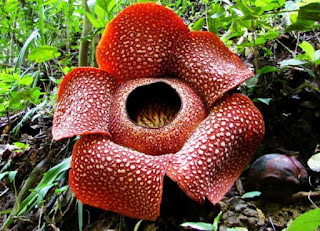RAFFLESIA ARNOLDII
 |
| Photo of Rafflesia Arnoldii |
The flower of Rafflesia Arnoldii grow to a diameter of around one meter, but the greatest measured from reliable source is 105 meter. Rafflesia Arnoldii could weight up into 11 kg. These flowers emerge from very large, cabbage-like, maroon or magenta buds typically about 30 cm (12 in) wide, but the largest (and the largest flower bud ever recorded) found at Mount Sago, Sumatra in May 1956 was 43cm (17 in) in diameter.
Rafflesia is a rare flower an fairly hard to locate. It is hard to locate because the buds take a lot of time to develop but the flower only last a few days. the flower are unisexsual and thus proximity of male and female flowers is vital for successful pollination. These factors make successful pollination a rare event.
When it is ready to reproduce, a tiny bud forms outside the root or stem of its host and develops over a period of a year. The cabbage-like head that develops eventually opens to reveal the flower. The stigma or stamen are attached to a spiked disk inside the flower. A foul smell of rotting meat attracts flies and beetles to pollinate. To pollinate successfully, the flies and/or beetles must visit both the male and female plants, in that order. The fruit produced are round lots filled with smooth flesh including many thousands of hard-coated seeds that are eaten and spread by treeshrews. Elephants also affect the pollination of this flower and this type of pollination is known as Elephophily.
This flower is critically endangered. There are many threats for this flower. One of the threat is the areas where Rafflesia arnoldii grows have become popular tourist attractions. While such tourism has helped locals to conserve the species, the increased human activity has disturbed and reduced flower bud production at many locations.

Comments
Post a Comment